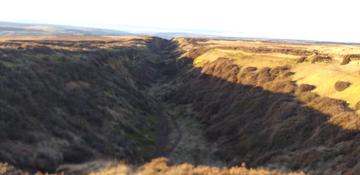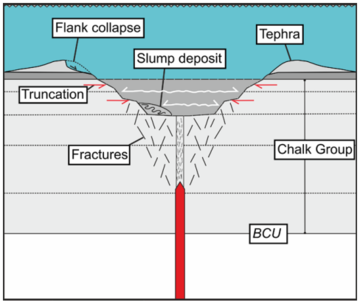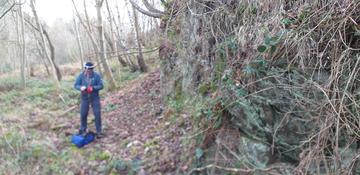Stopping magma in its tracks: how the Mull Dyke Swarm reached the North Sea
A new publication from the Department of Earth Sciences has explained how a set of giant dykes propagated across the UK and crossed into the North Sea during the late Palaeocene. A graduate of our MEarthSci programme Evan Pryce led this research, which was recently published in the journal Geology.

Cleveland Dyke, quarried for roadstone on the North York Moors (Image Credit: Joe Cartwright)
Magmatic dykes are a common geological feature on Earth, formed when a host rock fractures and dilates due to pressure from magma (which then solidifies in the vacant space). During the formation of large igneous provinces, long-range horizontal propagation of magma leads to the formation of giant dyke swarms over hundreds to thousands of kilometres. These commonly radiate from a central point, which forms the source of this extensive magmatic plumbing system. Dyke swarms represent some of the largest magma flux events in the geological record.

Diagram to show how pit crater formation was caused by a phreatomagmatic eruption when a dyke reached the near surface. Image from original article, available at https://doi.org/10.1130/G52490.1 (Figure 4).
Understanding how dyke swarms form is a critical question for geologists, who seek to study these features on Earth, as well as the hundreds observed on Venus and Mars. Despite their prevalence, scientists are still trying to understand why these dykes propagate for such large distances laterally without leading to the eruption of magma at the surface - which they believe is a key factor in how they are able create such extensive networks inside the crust. If they were to reach the surface and erupt, the dyke swarm would stop propagating due to insufficient magma supply.
A new study by Evan Pryce, Joe Cartwright, Chris Kirkham and Daniel Phillips of Oxford Earth Sciences has tackled this question using a combination of 3D seismic data and information from exploration wells. Their research focussed on the 58 million-year-old Mull Dyke Swarm – so called because it spans from the Isle of Mull into the southern North Sea. The Mull Dyke Swarm is the longest continuously mapped swarm on Earth, and is thought to have originated from beneath a large volcano under Mull (with a magma chamber as big as 100 km3). However, on land, the top sections of each dyke are often eroded away, leaving little evidence of what stopped the dyke from reaching the surface. Instead, the research team were able to use the part of the swarm which is preserved under the North Sea to examine the upper regions of the dykes more closely.

Crop of the Cleveland Dyke near Egham Bridge, North Yorkshire, featuring alumnus Chris Danilewicz
This marks the first time that scientists have used a combination of seismic and well data to investigate this problem – and this was key to revealing what happened when the magma in the dyke rose up towards the surface. Thanks to this approach, the research team were able to determine that it was an interaction between this magma and water which stopped the magma from erupting as a lava fountain. These 'phreatomagmatic eruptions' caused the magma to cool and become more viscous. With a new dead-end created in the magmatic plumbing system, the dykes continued to expand sideways underground, promoting long-range propagation of the swarm across the North Sea.
This mechanism also explains why large craters are often found above the uppermost sections of dykes, known as pit crater chains. When magma and water meet, they react explosively, creating large depressions which are surrounded by tephra (tiny shards of volcanic glass). In fact, it was the identification of this tephra which led the research team to confidently conclude that phreatomagmatic eruptions were taking place in these locations.
“It was a pleasure working with Evan on his two projects, and am thrilled to see two such great papers come from all his hard work. This just shows what amazing things our students can achieve.”
- Professor Joe Cartwright
This publication is the second authored by Evan, who graduated from the Department’s MEarthSci programme in 2024. Our undergraduate courses provide students with numerous opportunities to lead their own research, including a data-based project (often based on geological mapping) at the end of the second year, an extended essay during the third year, and an individual research project which is the primary focus of the fourth year. This paper resulted from Evan’s fourth year research project, which he undertook under the supervision of Professor Joe Cartwright.
“It’s always really nice to see the hard work of our 4th year students being recognised externally by the publication of their work in top academic journals, such as Geology. It underlines our belief that the 4th year is a great training ground for students to gain high-quality research experiences that are relevant to their future careers in industry, academia and elsewhere. As one of Evan’s former tutors at St Anne’s, I’m especially proud to see his work with Joe Cartwright recognised and accepted by Geology - it is a great achievement.”
- Professor Stuart Robinson, Associate Head of Department (Teaching)
The article “Sequential phreatomagmatic eruptions during the lateral propagation of giant dyke swarms” is available to read online at https://doi.org/10.1130/G52490.1.
Acknowledgements: The work could not have happened without the generous support of the North Sea Transition Authority. The authors would also like to thank SLB for providing an academic licence for Petrel.




